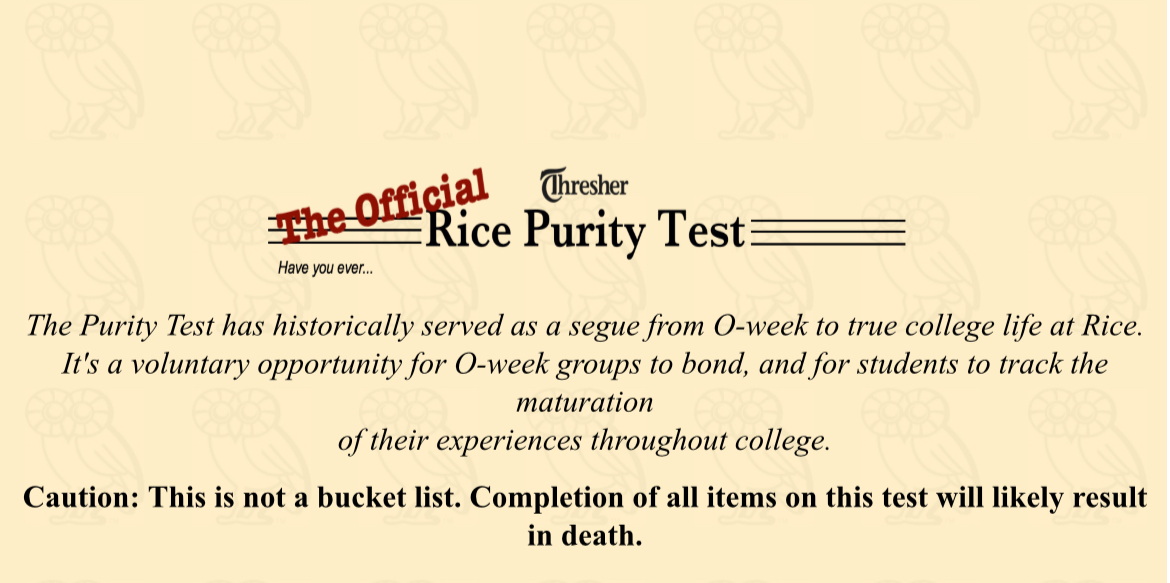
By Frannie Edwards-Hughes
Chances are you’ve taken the viral “Rice Purity Test” at some point, rating your supposed innocence by answering questions about your experiences. While it may seem like a harmless way to share stories and experiences with friends, this viral phenomenon hides a troubling history steeped in sexism and racism.
Jenna Hlavaty (‘24), who is doing her honors senior thesis on the Rice Purity Test, provided helpful historical information and context about the test. The Rice Purity Test was first introduced by Rice University in 1924. At this time, the test had only 10 questions, and it was given strictly to female-identifying students. While the questions on the original test are more straightforward than they once were, they have always had sexual undertones. For example, one of the original questions asked, “Have you ever done anything that you wouldn’t tell your mother?” The test functioned as a survey designed to measure women’s “purity” at the university. After the first group of women took the survey, an average score of 62 was reported. Following these results, the university newspaper published an article titled, “Rice Girls Not Quite Half Bad”. This article discussed how each grade of women scored and what that indicated about them, stating that freshmen “do come to college young and unsophisticated, and they become demoralized year by year”.
Although the test was supposed to be something seen as lighthearted it quickly became something more. In the eyes of male students, having a low score made a woman less “pure” and more immoral. The article published in the school’s paper only further reinforced the idea that men should be allowed to comment on the actions and choices of female students. “The first test was only given to women, and so this test originated as a way to police women and their sexualities as well as compare women to one another,” Hlavaty said.
By 1974, when male students first started taking the test, it was still the same 10 questions written with harmful binary language regarding sex. The test became a crucial aspect of Rice University’s orientation for freshman students. Students were given a purity sheet that they wore on their shirts as name tags. On the sheet, they would cross out what they had done in terms of alcohol, drugs, and sex. All first-year students would meet each other wearing their “purity” scores on their chests.
The test quickly grew, and in 1988, the next version was published, which consisted of 150 questions. This test was changing with time, and it now included questions regarding same-sex relationships. However, all the same-sex questions were distinct from the opposite-sex questions. Having two separate questions further isolated queer people, as it meant that individuals who considered themselves to be bisexual or had relationships with people outside of the opposite sex received lower purity scores. This label of being less “pure” due to having a lower score, further demonized queerness and isolated the LGBTQIA+ community at Rice.
The Rice Purity Test has developed over time alongside university changes. Following Rice’s admission of students of color in 1963, questions about crime were added to the test. These included questions like, “Have you ever been arrested?”, or “Have you ever had the police called on you?” Hlavaty points out that “for white people, it’s like a moral judgment, but then for anybody who’s not white who takes this quiz, it’s basically just a measure of systematic racism.” Students of color faced more discrimination by law enforcement, and this test states that they were essentially less “pure” than their white peers because of that injustice. Alarmingly, these same discriminatory questions exist in the current online version of the Rice Purity Test.
The current Rice Purity Test accessible online has not been updated since 2012, allowing its deeply troubling roots to remain firmly planted. Its continued popularity as a “harmless” viral trend among teens across the world has remained. Although the test may present itself as a fun way to get to know a friend or partner, it has extremely negative implications that uphold sexism, racism, and oppressive moral puritanism that should not be ignored. The test’s very foundation is built upon the notion of judging people’s “purity” and worth based on regressive ideals around gender, sexuality, and criminal injustice. Reducing entire populations to numbers that essentialize their experiences promotes dangerous judgment, shames normal human behavior, and reinforces oppressive systems. Sharing experiences in ways that uphold values of equality and understanding is preferable to the Rice Purity Test, which needs desperately to be reevaluated to uphold a more modern perspective.
